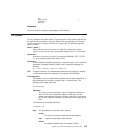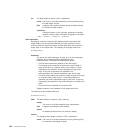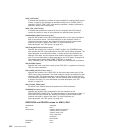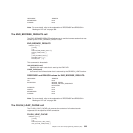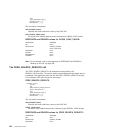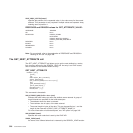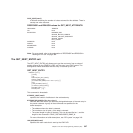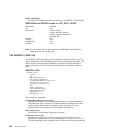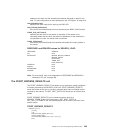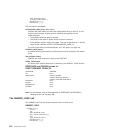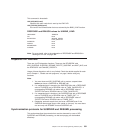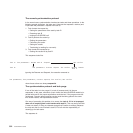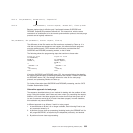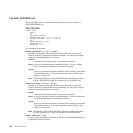VALUE_COUNT(name4)
a fullword containing the number of values returned for this attribute. There is
usually one value returned.
RESPONSE and REASON values for GET_NEXT_ATTRIBUTE:
RESPONSE REASON
OK None
EXCEPTION BROWSE_END
INVALID_BUFFER_LENGTH
INVALID_CALLING_SEQUENCE
INVALID_TOKEN
NOT_FOUND
DISASTER None
INVALID None
KERNERROR None
PURGED None
Note: For more detail, refer to the explanation of RESPONSE and REASON in
“Making an XPI call” on page 308.
The GET_NEXT_ENTRY call
The GET_NEXT_ENTRY call allows you to get the next entry, from a series of
entries returned by the SEARCH_LDAP call. An entry is an LDAP record. The
distinguished name associated with the entry is returned by this call.
GET_NEXT_ENTRY
DFHDDAPX [CALL],
[CLEAR],
[IN,
FUNCTION(GET_NEXT_ENTRY),
SEARCH_TOKEN(name4),
[DISTINGUISHED_NAME(buffer-descriptor),]]
[OUT,
[LDAP_RESPONSE(name4),]
[ATTRIBUTE_COUNT(name4),]
RESPONSE(name1 | *),
REASON(name1 | *)]
This command is threadsafe.
ATTRIBUTE_COUNT(name4)
specifies the number of attributes in the retrieved entry.
DISTINGUISHED_NAME(buffer-descriptor)
indicates the buffer where you want the distinguished name of the next entry in
the search returned. A group of three fullwords are specified for the
buffer-descriptor:
v The address where the data is returned.
v The maximum size in bytes, of the data is returned.
v The actual length in bytes of the data. This can be specified as *, and the
length is then returned in DDAP_DISTINGUISHED_NAME_N.
For more information on buffer-descriptors, see “XPI syntax” on page 319.
LDAP_RESPONSE(name4)
specifies the return code that is sent by the LDAP API.
Chapter 3. The user exit programming interface (XPI) 327



